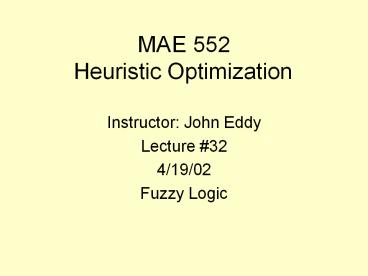MAE 552 Heuristic Optimization - PowerPoint PPT Presentation
Title:
MAE 552 Heuristic Optimization
Description:
MAE 552 Heuristic Optimization Instructor: John Eddy Lecture #32 4/19/02 Fuzzy Logic – PowerPoint PPT presentation
Number of Views:87
Avg rating:3.0/5.0
Title: MAE 552 Heuristic Optimization
1
MAE 552 Heuristic Optimization
- Instructor John Eddy
- Lecture 32
- 4/19/02
- Fuzzy Logic
2
Fuzzy Logic
- References
- NeuroFuzzy Adaptive Modeling and Control,
Martin Brown and Chris Harris, Prentice Hall,
1994 - http//www.seattlerobotics.org/encoder/mar98/fuz/f
lindex.html
3
Fuzzy Logic
- Background
- The optimization problems we are used to are in
the form - Min
- S.T.
4
Fuzzy Logic
- So these formulations are given in precise
mathematical terms. - For example, if we are optimizing a beam for some
load and we put a constraint in our formulation
that states that the stress must be less than
30,000 psi, then a beam for which the max stress
is 30,001 psi is considered infeasible. - Really, there is no practical difference between
30,000 psi and 30,001 psi.
5
Fuzzy Logic
- So many real world problems are better stated in
imprecise terms. - Such terms imply that a particular range of
values are considered acceptable and that the
level of acceptability is dependent on where a
particular value lies in that range.
6
Fuzzy Logic
- For example, some fuzzy statements are as
follows - The beam carries a large load
- - fuzziness implied by the word large
- The beam carries a load of 1000 lbs with a
probability of 0.8 - - fuzziness implied by the probabilistic nature
of the load.
7
Fuzzy Set Theory
- Consider X to be a set of all possible members of
a class. In that sense, it represents the entire
universe for that class. - The elements of class X are denoted by x.
- Also consider A to be a subset of X.
8
Fuzzy Set Theory
- We can describe membership in A with a
characteristic function, , which can take
on a value 0, 1 . - A value of 0 indicates complete non-compliance
with the premise of A, and a value of 1 indicates
complete compliance with the premise of A.
9
Fuzzy Set Theory
- Mathematically
- This is referred to as a valuation set.
10
Fuzzy Set Theory
- Our subset A becomes a fuzzy set if we allow its
valuation set to take on all values in 0, 1 . - And we can thus define the set A by a collection
of pairs comprised of a member value and its
associated characteristic function value for A as
follows.
11
Fuzzy Set Theory
- So for example, let X represent all possible
temperature settings for a thermostat and A
represent all comfortable temperatures for human
activity. - X may be
- X 62, 64, 66, 68, 70, 72, 74, 76, 78, 80
12
Fuzzy Set Theory
- A may then look something like
- A (62, 0.2), (64, 0.5), (66, 0.8), (68,
0.95), - (70, 0.85), (72, 0.75), (74, 0.6), (76, 0.4),
(78, 0.2), - (80, 0.1)
- So we see that different temperatures satisfy the
requirements of membership in A by different
amounts.
13
Fuzzy Sets vs. Crisp Sets
14
Fuzzy Set Theory
- So there is some correlation between crisp sets
and fuzzy sets. Do the same operations exist for
fuzzy sets that exist for crisp sets (union,
intersection, complement) as shown below?
15
Fuzzy Set Theory
- The answer is yes.
- The figure below shows the fuzzy union of some
fuzzy sets A and B.
16
Fuzzy Set Theory
- The figure below shows the fuzzy intersection of
some fuzzy sets A and B.
17
Fuzzy Set Theory
- Finally, the figure below shows the fuzzy
complement of some fuzzy set A.
18
Fuzzy System Optimization
- Our conventional optimization typically entails
finding the set of design parameters that
minimizes some objective function subject to some
constraints. - For fuzzy systems, this notion has to be revised
because we do not have a precise mathematical
representation for our system.
19
Fuzzy System Optimization
- Since our objective and constraint functions are
characterized by membership functions in our
fuzzy system, a design can be viewed as the
intersection of these fuzzy functions. - Consider the following example.
20
Fuzzy System Optimization
- Suppose we have an objective stated as
- The depth of the crane girder (x) should be
substantially greater than 80 in. - Our membership function for this statement may be
something like
21
Fuzzy System Optimization
- Suppose we also have a constraint stated as
- the depth of the crane girder (x) should be in
the vicinity of 83 in - The corresponding membership function might be
22
Fuzzy System Optimization
- So the fuzzy intersection of these two functions
is given by
23
Fuzzy System Optimization
- A plot containing the membership functions for
both the objective and constraints is shown below.
24
Fuzzy System Optimization
- The fuzzy feasible space is defined by the
intersection of all the fuzzy constraint
membership functions. It has a membership
function - Where Gj denotes the fuzzy set to which gj should
belong.
25
Fuzzy System Optimization
- The optimal value is at the maximum intersection
of the objective membership function and the
fuzzy feasible space.































